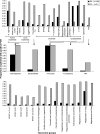Targeted PCR for detection of vaginal bacteria associated with bacterial vaginosis
- PMID: 17687006
- PMCID: PMC2045326
- DOI: 10.1128/JCM.01272-07
Targeted PCR for detection of vaginal bacteria associated with bacterial vaginosis
Abstract
Several novel bacterial species have been detected in subjects with bacterial vaginosis (BV) by using broad-range PCR assays, but this approach is insensitive for detecting minority species. We developed a series of taxon-directed 16S rRNA gene PCR assays for more sensitive detection of key vaginal bacteria. We sought to determine the prevalence of each species in the vagina, its association with BV, and the utility of PCR for the microbiological diagnosis of BV. Targeted PCR assays were developed for 17 vaginal bacterial species and applied to 264 vaginal-fluid samples from 81 subjects with and 183 subjects without BV. The results were compared to those of two widely accepted methods for diagnosing BV, the use of clinical findings (Amsel criteria) and the interpretation of vaginal-fluid Gram stains (Nugent criteria). Leptotrichia/Sneathia, Atopobium vaginae, an Eggerthella-like bacterium, Megasphaera species, and three novel bacteria in the order Clostridiales are among the bacterial species significantly associated with BV. PCR detection of either a Megasphaera species or one of the Clostridiales bacteria yielded a sensitivity of 99% and a specificity of 89% for diagnosis of BV compared to the Amsel clinical criteria and a sensitivity of 95.9% and a specificity of 93.7% compared to the Nugent criteria (Gram stain). PCR detection of one or more fastidious bacterial species is a more reliable indicator of BV than detection of bacteria, such as Gardnerella vaginalis, previously linked to BV, highlighting the potential of PCR for the diagnosis of BV.
Figures
References
-
- Amsel, R., P. A. Totten, C. A. Spiegel, K. C. Chen, D. Eschenbach, and K. K. Holmes. 1983. Nonspecific vaginitis. Diagnostic criteria and microbial and epidemiologic associations. Am. J. Med. 74:14-22. - PubMed
-
- Burton, J. P., and G. Reid. 2002. Evaluation of the bacterial vaginal flora of 20 postmenopausal women by direct (Nugent score) and molecular (polymerase chain reaction and denaturing gradient gel electrophoresis) techniques. J. Infect. Dis. 186:1770-1780. - PubMed
-
- Fredricks, D. N., T. L. Fiedler, and J. M. Marrazzo. 2005. Molecular identification of bacteria associated with bacterial vaginosis. N. Engl. J. Med. 353:1899-1911. - PubMed
-
- Fredricks, D. N., and D. A. Relman. 1999. Paraffin removal from tissue sections for digestion and PCR analysis. BioTechniques 26:198-200. - PubMed
Publication types
MeSH terms
Grants and funding
LinkOut - more resources
Full Text Sources
Other Literature Sources
Medical


